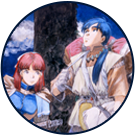Hello, this is Director Lee Jong-ju.
I have to admit, I tried to get this note out to you as soon as possible, but time really flew by faster than I expected.
Before I start, I'm a bit nervous about how readable the note might be, given its length (I haven’t written much yet though).
In an effort to make this rather lengthy note more engaging, I've decided to include some appropriate videos and images throughout.
Before we dive into the main content, I want to share something interesting with you. We recently conducted a poll to find out which of the original titles was the most popular among fans. The results surprised me! I had expected titles 3 and 4 to have a higher ratio, but even title 5 received an unexpectedly high number of votes. This really drove home the fact that each of the original games in the series is truly loved, and no title has been left behind in fans' hearts.
Where did I cast my vote? Personally, I’ve played The Legend of Heroes IV: A Tear of Vermillion the most out of all the games in the series.
I think one of the game's biggest charms is that you can set a different goal each time you play. For example:
-Completing every single request from the Guild
-Clearing the game with different combinations of Avin’s black magic, white magic, four elemental spirits, and special skills
-Clearing the game with weaker characters (with Archem’s help)
Unlike titles 3 and 5, where you're bound to a specific hero lineup, the 4's appeal lies in its variety. You can choose different heroes, focus on their unique growth paths, and even change direction whenever you play.
But here's a twist – despite what you might have guessed (and I may have unintentionally led you to believe), I didn't actually vote for “The Legend of Heroes IV”! As the game approaches its latter part, "The Prophecy of the Moonlight Witch" has such a touching story and a climactic ending that it still brings tears to my eyes. That lingering emotion swayed my heart, and I couldn't help but cast my vote for "The Prophecy of the Moonlight Witch."
Oh, I almost got sidetracked there. Today's note isn't really about the poll. I'm here to talk about the topic you're most curious about: "How will the three original series unfold in The Legend of Heroes: Gagharv Trilogy?"
This was chosen as the most anticipated topic.
Coming in a close second was the question of "The direction of the next scenario after the conclusion of the main story." I'll cover this in the next post, but for now, let's dive into today's main topic.
I've been pondering why the method of unfolding the story is such a curious and intriguing part for many of you. After some thought, I realized it's because even though the worldviews are connected, each series is quite different, with unique protagonists. This makes it hard to guess whether the story will unfold linearly or if you'll be able to choose which series to start with.
I also struggled with this very question when I first started preparing the game.
Initially, I toyed with a concept similar to a famous JRPG where eight travelers have their own episodes. However, I realized that switching between series midway could hinder your understanding and immersion in the story. While this approach might work for shorter episodes, I felt it would be detrimental to The Legend of Heroes' extensive world-building. So, I decided not to adopt that method.
After much consideration, I've decided to proceed chronologically according to the Gagharv timeline:
The Legend of Heroes IV: A Tear of Vermillion ->The Legend of Heroes V: A Cagesong of the Ocean -> The Legend of Heroes III: Prophecy of the Moonlight Witch
The game is designed so that after you complete all the adventures and the main scenario in A Tear of Vermillion, you'll move on to A Cagesong of the Ocean, and then finally to Prophecy of the Moonlight Witch.
Now, let me explain how you'll acquire heroes in each scenario. At the beginning of each scenario, you'll automatically receive that scenario's main heroes:
A Tear of Vermillion: Avin, Mile
A Cagesong of the Ocean: Forte, Una, McVein
Prophecy of the Moonlight Witch: Jurio, Chris
These main heroes will be provided by the system, not through Summon. We've carefully balanced the game so that you can support these heroes through quest rewards until they reach their final growth stages.
The game's environment is built around two main concepts: Towns and Adventure maps.
Towns are the place where you'll progress through the main scenario, chat with NPCs, and swap out your equipment. Speaking of towns, why don't we take a little break and indulge in some nostalgia? I've prepared a videoshowcasing one of the towns.
(It's in 4K resolution and includes sound. I went on this journey with Aida.)
There were two original elements that I absolutely refused to compromise on:
1. The anticipation of discovering what new scenario will unfold and what equipment upgrades await you when you arrive at the next town.
2. The joy of naturally absorbing the universe through conversations with NPCs and moments that elicit a spontaneous chuckle during the conversations.
To me, these are the quintessential charms that only classic RPGs can truly deliver.
Now, I'll let you in on a behind-the-scenes challenge we faced. To faithfully recreate the Legend of Heroes universe, we need to create over 70 different towns, both large and small. Given our development timeline, this requires a tremendous amount of resources. And this was definitely a major concern during the early stages of development.
We did consider simpler methods, like advancing the scenario and upgrading equipment through menu buttons – a common approach in many modern games. But I realized that without those two key elements I mentioned earlier, our game would lose its uniqueness. It would blend in with countless others and, worst of all, disappoint those of you expecting the nostalgia of the original.
So, we made the bold decision to stick to our original plan. Our internal art team has been working tirelessly (and they're still at it!), but seeing the final results – both visually and in terms of gameplay – I think we made the right choice.
You'll also be able to purchase equipment and items from shops in these towns. To do this, you'll use the currency you'veacquired from looting during your adventures- but more on that in the next part.
Oh, I can't believe I almost forgot to mention this - there's a familiar feature (or as I like to call it, an old friend) from The Legend of Heroes IV that's making an unique identity of the game: the Request Office. This was such a key element of the original game that we knew we had to include it.
In our new game, we've designed it so that the Request Office is present in every town. Now, I'll be honest - it's been quite challenging to fully capture the unique economic system that centered around the Request Office in The Legend of Heroes IV. But we're working hard to express it in a different style.
Now, let me explain the Adventure Map in more detail.
The Adventure Map, simply put, represents the space where you encounter and fight monsters between towns in the original game. But before I dive into the details, let's watch a video of it before continuing.
Initially, I considered creating an adventure map where players could manually navigate between fields, just like in the original game. However, after thinking about the mobile environment and the farming system we wanted to implement (which is related to a ticket and stamina system), we decided to go in a different direction.
Instead, we've implemented a stage-based format, as you saw in the video. Each chapter features unique caves with special farming opportunities and the chance to acquire rare items. We've also reimagined how the hidden treasure chests work, adding a new twist to exploration.
Players can explore stages and caves through actual controls, giving you that hands-on feel. But we also know that sometimes you just want to get things done quickly, so we've implemented some convenience features too. If there's interest, I'd be happy to explain these in more detail in a future post.
One of these convenience features is the ability to quickly move to the village. However, for those of you who want to experience that nostalgic feel of the original game, we make it possible that you can still manually move to the village if you prefer. (Between us, internally, most of our team members tend to use the convenience features.)
Now that we've covered the two main components, let's dive into how the story of our game will unfold in its early stages.
The main scenario kicks off at Lemuras and Avin's Lookout Cottage (which some of you might remember as simply "the Cottage" from the original Legend of Heroes IV).
The story development is based on the new Legend of Heroes IV, not the old one.
For those of you who fondly recall the old Legend of Heroes IV, you might remember how the story began in the cottage, Avin and Mile choosing between meat or vegetable dishes, and undergoing training from Lemuras.
Our version, Avin's journey begins with a heart-wrenching split from Eimelle at the Cathedral. This experience leaves him deeply wounded, causing him to shut others out. And Avin meets a friend named Mile in Ourt Village, who helps him gradually open his heart again.
We've put a lot of effort into portraying this emotional journey. It adds depth to Avin and Mile's relationship, showing why they were able to trust each other so completely and remain companions until the very end.
This version also supplements and strengthens the overall story and character relationships. So, for those of you who only played the old version, you'll encounter many new story elements.
I hope I've addressed some of the questions you might have had, but if there are any unresolved points, please don't hesitate to leave a comment. I'll do my best to address anything I can.
As I write this, I can't help but feel like I've gone off on quite a tangent. I'm a bit worried that this has turned into a lengthy and potentially hard-to-read text. ;(
Next time, I'll be back with a discussion on the "Direction of the Next Scenario after the Main Scenario (Ending)." I'm already looking forward to sharing more with you all.
I’m sorry for bothering you with this rambling and lengthy post, and thank you for your endurance.
Director Lee Jong-ju
P.S. This is my favorite location from the game. Let’s take a moment to enjoy it together




